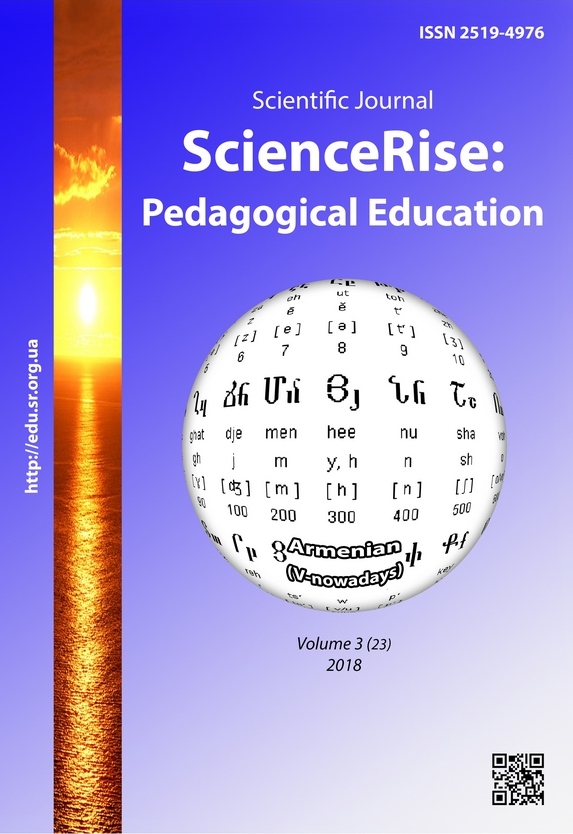Development of model of cooperation of general and out-of-school educational institutions in the aesthetic education of teenagers
DOI:
https://doi.org/10.15587/2519-4984.2018.126847Keywords:
aesthetic education, interaction, interaction of adolescents, interaction model, mesolevel, microlevelAbstract
One of the most important tasks of education is to prepare a child for successful self-realization in life. The modern pupils today are focused on getting a certain amount of knowledge, so school is in need of a fundamental reform.
A teacher is the foreground personality in the development of the model of interaction of secondary and out-of-school education in the aesthetic education of teenagers. In our understanding, the basis for the development of the methodical provision of interaction of secondary and out-of-school education in the aesthetic education of adolescents depends on the ability of a teacher to transform the inclinations and abilities of the pupils.
A teacher understands, assumes and uses the age and psychological characteristics of teenagers. Every teacher knows the classification of basic personality traits and can influence their formation.
Organization of interaction of secondary and out-of-schools education in the aesthetic education of teenagers is based on the results of the analysis of their practical and aesthetic activities and takes into account the components of aesthetic education: emotional, informational, communicative.
In the interaction of secondary and out-of-school education in the aesthetic education of teenagers the methodological basis is the integration of knowledge in the field of aesthetics, pedagogy, ethics, psychology, theories of aesthetic education
References
- Komarovska, O. A. (2015). Teoretiko-metodichni zasadi rozvitku hudozhno obdarovanoYi osobistostI u shkolah estetichnogo vihovannya. Kyiv, 42.
- Rudnitska, O. P. (2005). Pedagogika: zagalna ta mistetska. Ternopil: Navchalna kniga – Bogdan, 360.1. Semenov, M. R. (Ed.) (1991). Aesthetic education in school. Kazan: Publishing KSU, 184.
- Lavrish, I. M. (2008). Metodika formuvannya estetichnih orientatsiy pidlitkiv zasobami dityachogo muzichnogo teatru-studiyi. Kyiv, 178.
- Pustovit, G. P., Tihenko, L. V. (2008). Pozashkilna osvita: didaktichni osnovi metodiv navchalno-vihovnoyi roboti. Book 2. Sumi: Universitetska kniga, 272.
- Semenov, M. R. (Ed.) (1991). Aesthetic education in school. Kazan: Publishing KSU, 184.
- Kwiatkowski, E. V.; Gerasimov, S. A. (Ed.) (1983). Metodologicheskie problemy sovershtnstvovania systemy estetichtakogo vospitania. Systema estetichtakogo vospitania. Moscow: Pedagogika, 9–12.
- Levchuk, L. T. (1997). Istoriya mirovoy kulturyi. Leningrad: Iskusstvo, 336.
- Stuparik, B. M. (1994). Shkіlnitstvo Galychyna. Ivano-Frankivsk, 144.
- Florenskaya, G. A. (1978). Katarsis kak osoznanie. Bessoznatelnoe: priroda, funktsii, metodyi issledovaniya. Vol. 2. Tbilisi, 548.
- Moyseyuk, N. E. (2001). Pedagogіka. Kyiv: VAT «KDNK», 608.
- Nor, K. F. (2003). Vikoristannya amerikanskogo dosvіdu formuvannya komunіkativnih umіn maybutnіh uchitelіv. Naukovi pratsi. Pedagogіchnі nauki, 28 (15), 54–58.
- Korotaeva, E. V. (2000). Director-uchitel-uchenik: puti vzaimodeystviya. Moscow: September, 144.
Downloads
Published
How to Cite
Issue
Section
License
Copyright (c) 2018 Лариса Володимирівна Сєрих

This work is licensed under a Creative Commons Attribution 4.0 International License.
Our journal abides by the Creative Commons CC BY copyright rights and permissions for open access journals.
Authors, who are published in this journal, agree to the following conditions:
1. The authors reserve the right to authorship of the work and pass the first publication right of this work to the journal under the terms of a Creative Commons CC BY, which allows others to freely distribute the published research with the obligatory reference to the authors of the original work and the first publication of the work in this journal.
2. The authors have the right to conclude separate supplement agreements that relate to non-exclusive work distribution in the form in which it has been published by the journal (for example, to upload the work to the online storage of the journal or publish it as part of a monograph), provided that the reference to the first publication of the work in this journal is included.








